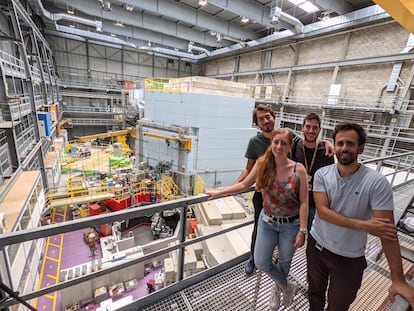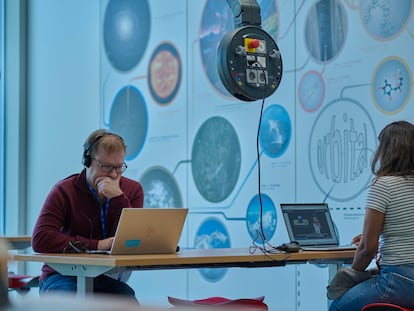Revealing the invisible: Neutron radiography opens window into behavior of internal fluids
The research could help improve the efficiency of flow batteries, which are key for energy from renewable sources due to their large-scale and long-lasting storage capacity

Conventional methods such as X-rays, CT scans or magnetic resonance imaging allow us to see parts of the inside of bodies and objects without opening them. But these extraordinary advances have a limitation: fluids and the behavior of the chemical elements that compose them over time remain invisible. Now, research led by the Spaniard Antoni Forner-Cuenca, a professor of electrochemical materials and systems at Eindhoven University of Technology (The Netherlands) who studied at the Massachusetts Institute of Technology (MIT), has managed to overcome this barrier. Using neutron x-rays, he has revealed the composition and behavior of the internal elements in a functioning battery. It cannot be used in living organisms due to the effect of radiation, but it is a door to the invisible world, as reported in Nature Communications.
The International Atomic Energy Agency (IAEA) defines “neutron imaging” as a non-destructive technique for analyzing the structure of a sample by passing a beam of neutrons through it and attenuating it according to its composition and shape. The results it provides are essential for the determination of hydrogen in electrochemistry analyses of fuel cells, the study of the dynamic efficiency and performance of batteries or engines, quality control in the automotive, aviation and construction industries, the non-invasive study of cultural heritage objects and biological samples, in geology, in the examination of nuclear fuel and in materials research.
The research by Forner-Cuenca and his team has gone a step further and, as the researcher explains, they have developed and demonstrated an imaging method with neutrons to visualize concentrations in liquids and their behavior in a flow battery.
“In a battery, there are a number of processes that occur inside it that determine its performance, efficiency and lifespan. Until now, it was a black box. You could measure the voltage and the electric current, but you didn’t know what was happening inside. With our method, we can take photos and videos of these processes during the operation of the battery and see how the concentrations inside the electrochemical cell change,” he explains.
The magicians who reveal these hitherto invisible processes are the neutrons, subatomic particles with no net charge and which, due to this characteristic, do not interact with electron clouds. The neutron passes through the external structure of the object as if it were transparent, but is attenuated when it encounters molecules containing hydrogen or boron.
The industrial application is obvious, especially to improve the efficiency of flow batteries, which are key for energy from renewable sources due to their large-scale and long-lasting storage capacity. “I see applications in various processes in the chemical industry, where there are conversions of molecules in the liquid phase, or to understand how prototypes work,” adds Forner-Cuenca.
Images of previously invisible spaces have revealed the movements of molecules, how they fluctuate during charging or discharging phases, the most inactive areas, or the precipitation of solids. All this information allows for the design of more efficient batteries.
The research was led by Spanish researcher Forner-Cuenca and his team (Maxime van der Heijden, Remy R. Jacquemond, and Emre B. Boz) at Eindhoven University of Technology, in collaboration with MIT and the Paul Scherrer Institute of Switzerland (PSI), which provided the facilities for the development of the experiments, which lasted for 12 days without interruption and with measurements every 30 seconds.
The European university’s line of work is shared by other international institutions because, says Santanu Roy, co-author of a study published in the Journal of the American Chemical Society, “a better capacity to predict and calculate microscopic behaviors, as well as obtaining reliable data, helps to develop better models.”
This scientist, who researches molten salts as fuel and reactor coolant, explains that “the chemical, structural and dynamic behavior of salts at the atomic level is difficult to understand.” When a beam of neutrons is aimed at a sample, many of them pass through the material, but some interact directly with atomic nuclei and “bounce” off at an angle, like balls colliding in a game of billiards. Using special detectors, scientists count the scattered neutrons, measure their energies and the angles at which they scatter, and map their final positions. This makes it possible to gain details about the nature of materials — from liquid crystals to superconducting ceramics, from proteins to plastics, and from metals to metallic glass magnets.
As part of the quest to improve device performance, Osaka University (Japan) has used neutrons to measure internal temperatures of electronic components quickly and accurately. The method, also published by Nature Communications, uses a technique called “neutron resonance absorption” to examine neutrons absorbed by atomic nuclei at certain energy levels and deduce the properties of the material. “This technology allows temperature to be measured instantaneously [100 nanoseconds] and, as it is non-destructive, it can be used to monitor devices such as batteries and semiconductor devices,” explains Zechen Lan, lead author of the paper.
Sign up for our weekly newsletter to get more English-language news coverage from EL PAÍS USA Edition
Tu suscripción se está usando en otro dispositivo
¿Quieres añadir otro usuario a tu suscripción?
Si continúas leyendo en este dispositivo, no se podrá leer en el otro.
FlechaTu suscripción se está usando en otro dispositivo y solo puedes acceder a EL PAÍS desde un dispositivo a la vez.
Si quieres compartir tu cuenta, cambia tu suscripción a la modalidad Premium, así podrás añadir otro usuario. Cada uno accederá con su propia cuenta de email, lo que os permitirá personalizar vuestra experiencia en EL PAÍS.
¿Tienes una suscripción de empresa? Accede aquí para contratar más cuentas.
En el caso de no saber quién está usando tu cuenta, te recomendamos cambiar tu contraseña aquí.
Si decides continuar compartiendo tu cuenta, este mensaje se mostrará en tu dispositivo y en el de la otra persona que está usando tu cuenta de forma indefinida, afectando a tu experiencia de lectura. Puedes consultar aquí los términos y condiciones de la suscripción digital.
More information
Archived In
Últimas noticias
NASA discovers Titan doesn’t have an ocean, but a ‘slushy ice layer’ that increases possibility of life
Innocence lost in the forest of the child soldiers: ‘Each leader of the armed group had his girls’
‘Fallout’ or how the world’s largest company turned an anti-capitalist apocalyptic Western into a phenomenon
From inflation to defending migrants: Eileen Higgins and Zohran Mamdani inaugurate the new Democratic resistance against Trump
Most viewed
- ‘El Limones’ and the growing union disguise of Mexican organized crime
- Christian Louboutin: ‘Young people don’t want to be like their parents. And if their parents wear sneakers, they’re going to look for something else’
- The low-cost creative revolution: How technology is making art accessible to everyone
- ‘We are dying’: Cuba sinks into a health crisis amid medicine shortages and misdiagnosis
- A mountaineer, accused of manslaughter for the death of his partner during a climb: He silenced his phone and refused a helicopter rescue











































